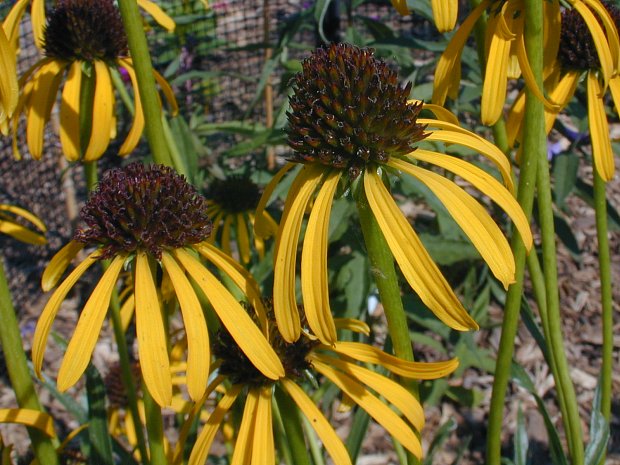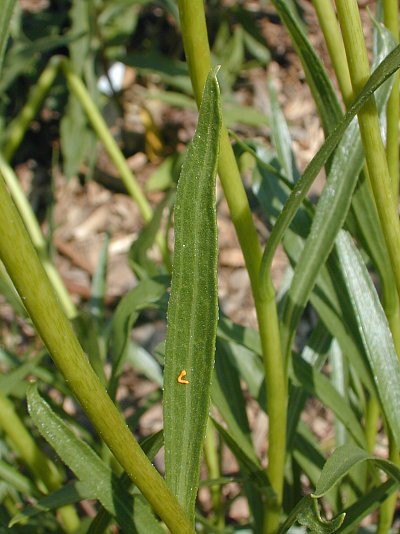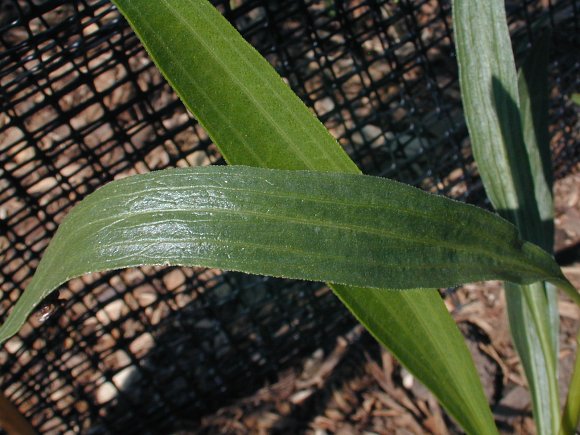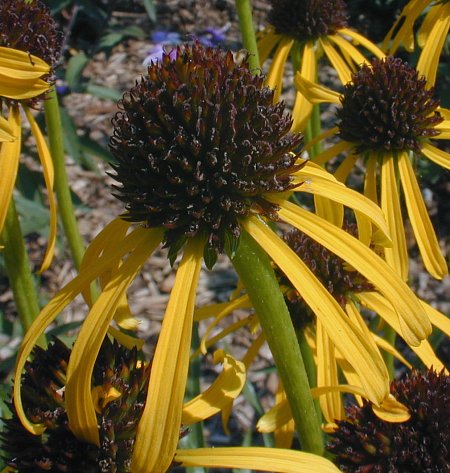
The central stem terminates in a solitary flowerhead on a long naked peduncle that is more or less erect. The peduncle is typically 4-12" long and its characteristics are similar to those of the central stem. Each flowerhead is about 2–2½" across, consisting of 10-30 ray florets that surround a central head of numerous disk florets. The central head is dark reddish brown to nearly black, dome-shaped to nearly globoid, and prickly in both appearance and touch from the hardened scales of its receptacle. The disk florets are up to ¼" (6 mm.) in length, narrowly tubular in shape, and 5-lobed. The petaloid rays of the flowerhead are yellow, narrowly oblong in shape, and descending. The blooming period occurs from late spring to mid-summer, lasting about 1 month for a colony of plants. Afterwards, the disk and ray florets are replaced by achenes. These achenes are 4-5 mm. long, narrowly oblongoid-angular in shape, tan to brown, and glabrous; their apices may have a crown of up to 4 minute teeth each. The root system consists of a taproot. This plant reproduces by reseeding itself.

Cultivation: The preference is full sun, mesic to dry conditions, and rocky soil. However, in cultivation it will adapt to most soil types if they are well-drained.
Range & Habitat: Currently there are no records of Ozark Coneflower naturalizing in Illinois, i.e., persisting in the wild for more than one year (see Distribution Map). However, the webmaster observed a single plant of this species (the typical variety) growing wild in an upland prairie at Meadowbrook Park in Urbana, Illinois, that persisted and flowered for a single year. Because Ozark Coneflower is occasionally cultivated in gardens, there exists the possibility that it could escape and naturalize within the state. The typical variety of this species, as described here, is endemic to Missouri and Arkansas, where it is found in such habitats as rocky prairies, hill prairies, glades, and bald knobs. This is regarded as a conservative species that is found in high quality natural areas where the original ground flora is still intact.

Faunal Associations: Information about floral-faunal relationships for this species is rather limited. The nectar and pollen of the flowerheads attract various insects, especially long-tongued bees, butterflies, and skippers. According to Covell (1984/2005), the caterpillars of some Geometer moths feed on the florets of coneflowers (Echinacea spp., Rudbeckia spp.) in the Aster family, including Chlorochlamys chloroleucaria (Blackberry Looper Moth), Eupithecia miserulata (Common Pug), and Synchlora aerata (Wavy-lined Emerald). Various grasshoppers feed on the foliage of Ozark Coneflower, although the presence of the Northern Fence Lizard (Sceloporus undulatus) near brush piles reduces the extent of the damage that these insects cause (Van Zandt et al., 2005). During late summer to early autumn, the Eastern Goldfinch eats the seeds of Ozark Coneflower and other Echinacea spp.

Photographic Location: A flower garden at the Arboretum of the University of Illinois in Urbana, Illinois.
Comments: Ozark Coneflower (Echinacea paradoxa paradoxa) can be distinguished from other coneflowers in the Echinacea genus by its yellow petaloid rays – all of the others have pink, light purple, purple, or white petaloid rays. The other variety of this coneflower, Bush's Purple Coneflower (Echinacea paradoxa neglecta), differs from the typical variety by having pink, light purple, or white petaloid rays and its achenes are at least partially hairy, rather than glabrous. This latter variety is endemic to Oklahoma and Texas. Ozark Coneflower superficially resembles Missouri Coneflower (Rudbeckia missouriensis), but the leaves and stems of the latter species are more hairy, its petaloid rays are widely spreading rather than drooping, and the head of its compound flower is relatively smooth, rather than prickly.